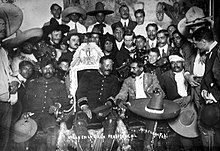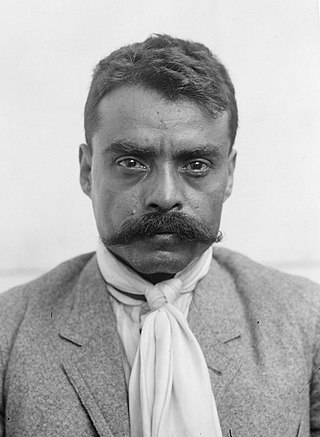
Emiliano Zapata Salazar was a Mexican revolutionary. He was a leading figure in the Mexican Revolution of 1910–1920, the main leader of the people's revolution in the Mexican state of Morelos, and the inspiration of the agrarian movement called Zapatismo.
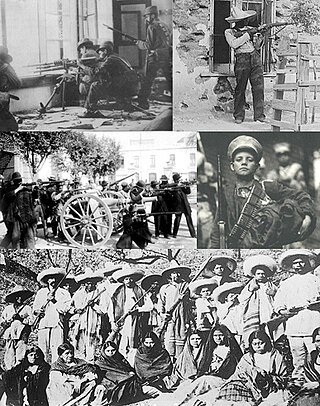
The Mexican Revolution was an extended sequence of armed regional conflicts in Mexico from 20 November 1910 to 1 December 1920. It has been called "the defining event of modern Mexican history". It resulted in the destruction of the Federal Army and its replacement by a revolutionary army, and the transformation of Mexican culture and government. The northern Constitutionalist faction prevailed on the battlefield and drafted the present-day Constitution of Mexico, which aimed to create a strong central government. Revolutionary generals held power from 1920 to 1940. The revolutionary conflict was primarily a civil war, but foreign powers, having important economic and strategic interests in Mexico, figured in the outcome of Mexico's power struggles; the U.S. involvement was particularly high. The conflict led to the deaths of around one million people, mostly noncombatants.
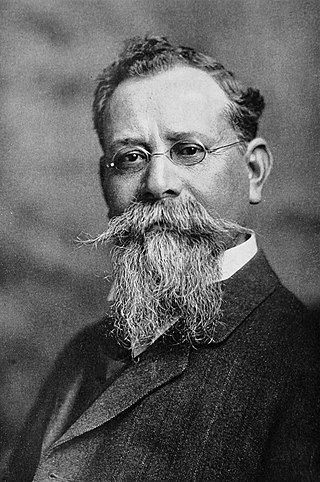
José Venustiano Carranza de la Garza was a Mexican land owner and liberal politician who served as President of Mexico from 1917 until his assassination in 1920, during the Mexican Revolution. He was previously Mexico's de facto head of state as Primer Jefe of the Constitutionalist faction from 1914 to 1917, and previously served as a senator and governor for Coahuila. He played the leading role in drafting the Constitution of 1917 and maintained Mexican neutrality in World War I.

Álvaro Obregón Salido was a Mexican military general and politician who served as the 46th President of Mexico from 1920 to 1924. Obregón was re-elected to the presidency in 1928 but was assassinated before he could take office.

Francisco Sebastián Carvajal y Gual, sometimes spelled Carbajal was a Mexican lawyer and politician who served briefly as president in 1914, during the Mexican Revolution. In his role as foreign minister, he succeeded Victoriano Huerta as president upon the latter's resignation.
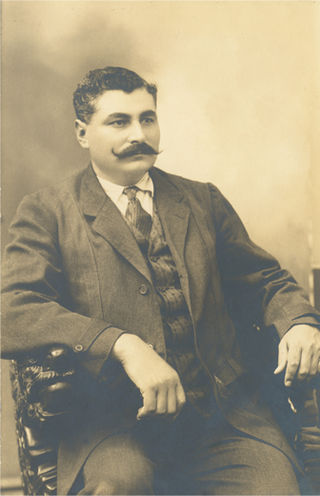
Eulalio Gutiérrez Ortiz was a general in the Mexican Revolution from state of Coahuila. He is most notable for his election as provisional president of Mexico during the Aguascalientes Convention and led the country for a few months between 6 November 1914 and 16 January 1915. The Convention was convened by revolutionaries who had successfully ousted the regime of Victoriano Huerta after more than a year of conflict. Gutiérrez rather than "First Chief" Venustiano Carranza was chosen president of Mexico and a new round of violence broke out as revolutionary factions previously united turned against each other. "The high point of Gutiérrez's career occurred when he moved with the Conventionist army to shoulder the responsibilities of his new office [of president]." Gutiérrez's government was weak and he could not control the two main generals of the Army of the Convention, Pancho Villa and Emiliano Zapata. Gutiérrez moved the capital of his government from Mexico City to San Luis Potosí. He resigned as president and made peace with Carranza. He went into exile in the United States, but later returned to Mexico. He died in 1939, outliving many other major figures of the Mexican Revolution.

Martín Luis Guzmán Franco was a Mexican novelist and journalist. Along with Mariano Azuela and Nellie Campobello, he is considered a pioneer of the revolutionary novel, a genre inspired by the experiences of the Mexican Revolution of 1910. He spent periods in exile in the United States and Spain. He founded newspapers, weekly magazines, and publishing companies. In 1958, he was awarded Mexico's National Prize in Literature.

The Liberation Army of the South was a guerrilla force led for most of its existence by Emiliano Zapata that took part in the Mexican Revolution from 1911 to 1920. During that time, the Zapatistas fought against the national governments of Porfirio Díaz, Francisco Madero, Victoriano Huerta, and Venustiano Carranza. Their goal was rural land reform, specifically reclaiming communal lands stolen by hacendados in the period before the revolution. Although rarely active outside their base in Morelos, they allied with Pancho Villa to support the Conventionists against the Carrancistas. After Villa's defeat, the Zapatistas remained in open rebellion. It was only after Zapata's 1919 assassination and the overthrow of the Carranza government that Zapata's successor, Gildardo Magaña, negotiated peace with President Álvaro Obregón.

In the history of Mexico, the Plan of Guadalupe was a political manifesto which was proclaimed on March 26, 1913, by the Governor of Coahuila Venustiano Carranza in response to the reactionary coup d'etat and execution of President Francisco I. Madero, which had occurred during the Ten Tragic Days of February 1913. The manifesto was released from the Hacienda De Guadalupe, which is where the Plan derives its name, nearly a month after the assassination of Madero. The initial plan was limited in scope, denouncing Victoriano Huerta's usurpation of power and advocating the restoration of a constitutional government. In 1914, Carranza issued "Additions to the Plan of Guadalupe", which broadened its scope and "endowed la Revolución with its social and economic content." In 1916, he further revised the Plan now that the Constitutionalist Army was victorious and revolutionaries sought changes to the 1857 Constitution of Mexico. Carranza sought to set the terms of the constitutional convention.

The Constitutional Army, also known as the Constitutionalist Army, was the army that fought against the Federal Army, and later, against the Villistas and Zapatistas during the Mexican Revolution. It was formed in March 1913 by Venustiano Carranza, so-called "First-Chief" of the army, as a response to the murder of President Francisco I. Madero and Vice President José María Pino Suárez by Victoriano Huerta during La Decena Trágica of 1913, and the resulting usurpation of presidential power by Huerta.
Events in the year 1914 in Mexico.
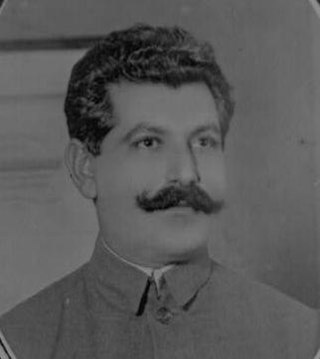
Lucio Blanco was a Mexican military officer and revolutionary, noteworthy for his participation in the Mexican Revolution of 1910 to 1920.

The Constitutionalists were a faction in the Mexican Revolution (1910–1920). They were formed in 1914 as a response to the assassination of Francisco Madero and Victoriano Huerta's coup d'etat. Also known as Carrancistas, taking that name from their leader, Venustiano Carranza the governor Coahuila. The Constitutionalists played the leading role in defeating the Mexican Federal Army on the battlefield. Carranza, a centrist liberal attracted Mexicans across various political ideologies to the Constitutionalist cause. Constitutionalists consisted of mainly middle-class urbanites, liberals, and intellectuals who desired a democratic constitution under the guidelines "Mexico for Mexicans" and Mexican nationalism. Their support for democracy in Mexico, caught the attention of the United States who aided their cause. In 1914, the United States occupied Mexico's largest port in Veracruz in an attempt to starve Huerta's government of customs revenue. They crafted and enforced the Mexican Constitution of 1917 which remains in force today. Following the defeat of General Huerta, the Constitutionalists outmaneuvered their former revolutionary allies Emiliano Zapata and Pancho Villa becoming the victorious faction of the Mexican Revolution. However the Constitutionalists were divided amongst themselves and Carranza was assassinated in 1920. He was succeeded by General Álvaro Obregón who began enforcing the 1917 constitution and calming revolutionary tensions. His assassination and the subsequent power vacuum this created spurred his successor, Plutarco Elías Calles to create the National Revolutionary Party (PNR) which would hold uninterrupted political power in Mexico until 2000.

Juan Andreu Almazán was a Mexican revolutionary general, politician and businessman. He held high posts in the Mexican Army in the 1920s and ran for the presidency of Mexico in 1940 in a highly disputed election, having accumulated great wealth from construction. General Almazán became one of Mexico's and Latin America’s wealthiest citizens in the early 1940s.
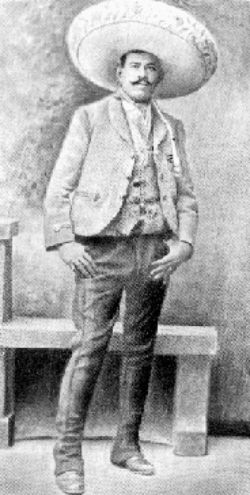
Amador Salazar Jiménez was a Mexican military leader who participated in the Mexican Revolution.

The Conventionists were a faction led by Pancho Villa and Emiliano Zapata which grew in opposition to the Constitutionalists of Venustiano Carranza and Álvaro Obregón during the Mexican Revolution. It was named for the Convention of Aguascalientes of October to November 1914.

Antonio Diaz Soto y Gama was a Mexican politician and revolutionary during the Mexican Revolution.

General Jacinto Blas Treviño González was a Mexican military officer, noteworthy for his participation in the Mexican Revolution of 1910 to 1921.
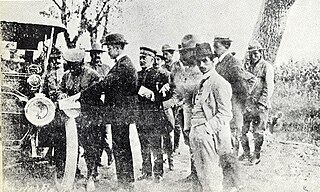
The Teoloyucan Treaties were signed on August 13, 1914, at Teoloyucan, State of Mexico, Mexico between the revolutionary army and forces loyal to Victoriano Huerta. The Constitutionalist Army of First Chief Venustiano Carranza was represented by Álvaro Obregón and Lucio Blanco. The Federal Army was represented by General Gustavo A. Salas and Admiral Othón P. Blanco, while Mexico City was represented by Eduardo Iturbe. The treaties established the surrender of the Federal Army and its dissolution.
